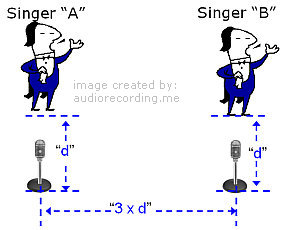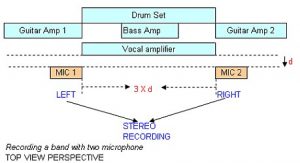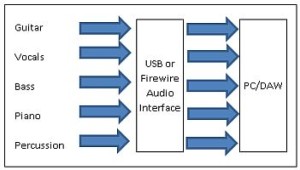Method #2: Two Microphones Live Recording Setup
In this setup, you can attain the stereo image of the band live performance. The resulting audio recording would now be in stereo since two microphones would be used to capture the performance. You can set it up as follows:
This method will implement the 3 is to 1 rule in microphone placement to fix phase cancellation issues in recordings.
In this method, you will place the guitar amplifiers, drum sets (no microphone is needed) and vocal amplifiers in front of these two microphones at some distance defined as “d”. Then these two microphones should be spaced at “3 x d” to minimize phase issues, see diagram below:
For example if the distance from the microphone to the band is 6 feet, then the microphones would be spaced at 6 feet x 3 or 18 feet from each other. These microphones can be two cardioid condenser microphones and a large diaphragm (LD) type. An LD condenser microphone is an advantage of picking up a wide response, more warmth and better bass response with less gain required for your audio interface preamp. Dynamic microphones such as SM-57 would be doable in a small room with nice sounding acoustics but it does not capture as detailed and open sounding as those recorded using large-diaphragm condenser microphones.
In some instances this method requires you to experiment with microphone placement until you get the best sound for recording. The recording chain is as follows:
1st/2nd microphone ==> Audio interface input 1/2===> USB/Firewire ==> Stereo recording to DAW
You can read this tutorial on how to record in stereo. In all methods, you will be doing several sound-checks, trials and microphone placement adjustments before you will be able to record the band with their best performance.
Method #3: Mixer stereo output method
In this method, you will need a mixing console. First you will need to connect your music instruments to the mixer such as shown below:
Then record the mixer stereo output to your audio interface as follows:
Instruments — > Mixer Preamp inputs (shown in screenshot above) — > Mixer stereo output — > Audio Interface Inputs — > Computer — > DAW (recording in stereo)
This method produces one of the cleanest live band recording performances because of the following advantages:
1.) The sound engineer can optimize the instrument recording levels by applying appropriate gain on the mixer preamp.
2.) The engineer can also apply effects such as EQ, compression, reverb that will enhance the sound quality.
3.) The stereo image can be improved by adjusting the mixer panning settings.
In some instances (depending on the skill of the engineer and the band), professional sounding recordings can be made using this method.
Method #4: Audio Interface Output Method
In this setup, you will not need an audio mixer but you need an audio interface capable of recording a full band live. You will mix inside your DAW (within your computer). The recording chain is as follows:
As you can see in the above screenshot, you need an audio interface with at least 5 inputs if you are setting up the band recording with the example above. However take note that the percussion is only using one input which is not always common.
Actual drum recording requires at least 3 microphones so you will need an audio interface that can simultaneously record 8 inputs total including guitars, etc. It is important that these inputs do have preamps on them so that the recording is clean.
Finally all these inputs would be tracked to your DAW via a multi-channel recording session. The band would be playing together like a normal live performance. The engineer can mix the band song inside the DAW to get the best results. Depending on the skill of the mixer, this method can produce professional sounding results.
Content last updated on June 14, 2012



